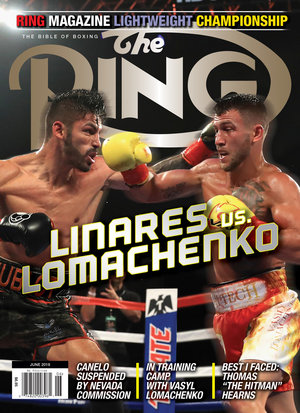The Travelin’ Man goes back to Las Vegas: Part two
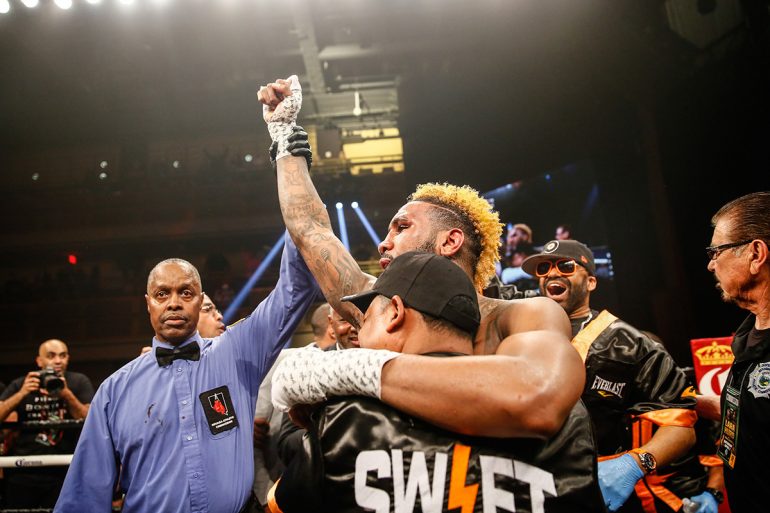
Please click here to read Part One.
Saturday, April 7 (continued): During last month’s snow-marred trip to New York City, I spent most of the night inside Washington, D.C.’s Union Station awaiting a train to the “Big Apple” that never ran. While there, I spoke with a man behind one of the counters who identified himself as a cousin of IBF junior middleweight champion Jarrett Hurd. When he asked me how Hurd should fight WBA counterpart Erislandy Lara, I offered the following advice: “Lara thrives on control, so Hurd must create chaos from the very start and maintain it until the end, so he would force Lara to fight harder and longer than he wants. That’s his only chance.”
My counsel was hardly original; I’m sure most people around him provided the same advice. But as anyone who has ever boxed will tell you, saying it and actually doing it are two completely different concepts, especially at the world-class level. Most of Lara’s previous opponents had the same game plan in mind and, while many have tried, only one opponent since November 2012 has walked out of Lara’s ring with a “W” – Saul Alvarez. Even so, the decision in “Canelo’s” favor was split and, if the numbers are any indicator, he might have been fortunate to get it. That’s because Alvarez was out-landed 107-97 overall (including 55-9 in jabs) and the round-by-round breakdowns had Lara leading 7-3-2 overall. But Alvarez’s aggression, superior shot-for-shot impact, star power and crowd support helped the Mexican overcome today’s dean of the “Cuban Boxing School.”
Since the Alvarez fight, Lara has had his way with foes frustrated by Lara’s defensive wizardry and extremely sharp counterpunching. Even as he neared his 35th birthday, Lara’s proficiency was off the charts; in his five fights before meeting Hurd, Lara’s opponents landed just 19.1% of their total punches, 12.4% of their jabs and 21.8% of their power shots – all below the division averages of 30%, 20.7% and 37% respectively. Meanwhile Lara landed 32.5% overall, 17.6% jabs and an impressive 54.7% power. His ring generalship was such that he limited opponents to 31.4 punches per round while throwing 42.8, both below the 56.4-per-round division average. For Lara, the slower the pace, the more time there is to think. And, at least most of the time, the more time Lara has to think, the better it is for him.
Hurd, on the other hand, thrived on using his size, strength and volume to break opponents’ skills and wills. In his five most recent fights before facing Lara, Hurd averaged 62 punches per round and connected with 37.4% overall, 24.8% jabs and 44.3% power. His risk-taking style resulted in elevated defensive numbers (29.8% overall, 21.1% jabs, 33.5% power) but, at 6-foot-1 and owning a 76-inch reach, his huge frame and above-average power made many – including me – believe that if anyone could force Lara into a firefight, Hurd could. And if he succeeded, all bets regarding the final result would fall to the wayside.
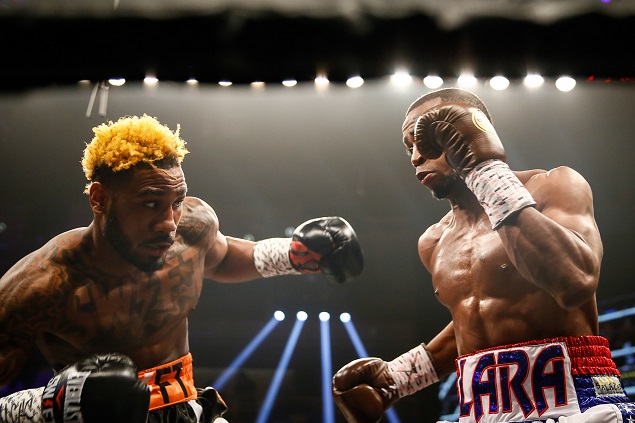
Photo credit: Stephanie Trapp/Trapp Photos/Showtime
The conventional wisdom around ringside was that the first three rounds would indicate the strength of Hurd’s bid to score the upset victory. The first round was a Lara-type round as he went 10 of 45 overall and landed 8 of his 17 power shots (47.1%), while limiting Hurd to 2 of 30 overall (6.7%), 0 of 12 jabs and 2 of 18 power (11.1%). But any thoughts of another professorial performance by Lara evaporated due to the events of rounds two and three. Hurd dramatically upped his work rate from 30 to 65 punches and though Lara out-landed him 20-13 overall and 6-0 jabs, Hurd succeeded in making Lara fight harder than usual, as the Cuban fired 61 punches and tasted 13 power shots while landing 14. Then, in round three, Hurd consolidated his strategic success by throwing 68 punches and out-landing Lara (who slowed to 44) 16-15 overall and 12-8 power. When Hurd continued that trend in the fourth (19 of 71 to 14 of 50 overall, 17 of 53 to 10 of 24 power), I knew he would force Lara to answer a question that had long been asked but never fulfilled: How would Lara react if an opponent successfully imposed extreme size, strength and pressure? It also would ask the following question of Hurd: Could he keep up the pace against his most calculating opponent to date?
The answers surfaced in rounds 8 through 12, a segment that saw Hurd average a robust 86.6 punches per round (topping off at 100 in round nine) and out-land Lara 128-79 overall, as well as 110-64 power. Yes, Hurd not only maintained the pace; he shifted into overdrive and punished Lara as never before, as he created several lumps on the Cuban’s face and inflicted considerable pain, thanks to his 54 landed body shots. Hurd capped his performance by scoring a knockdown in the final round, Lara’s first trip to the canvas, since round nine against Alfredo Angulo in June 2013. That knockdown lifted Hurd to a split decision win that averted what would have been a controversial draw otherwise.
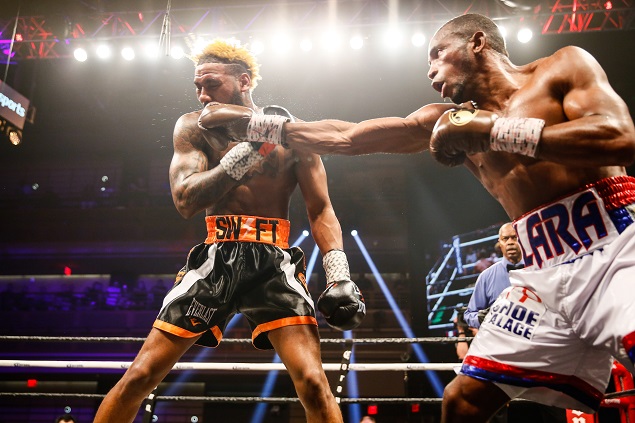
Photo credit: Stephanie Trapp/Trapp Photos
And yes, Lara showed a fighter’s courage and competitive drive, even in his most difficult moments. He pulled himself off the canvas and fought back as hard as he could under the circumstances. Hurd’s assets were just too much for him to overcome. Some might have thought Lara to be a passionless ring scientist, who would mentally check out under duress. In my eyes, he did no such thing; he lived up to the fighter’s code.
The final statistics backed up those judges who voted for Hurd (114-113 by Dave Moretti and Glenn Feldman) while contradicting the 114-113 score submitted by Burt Clements. I thought it to be a wider fight in Hurd’s favor (116-111) and my opinion was fortified by the round-by-round breakdowns that had Hurd up 8-4 overall and 10-2 power (Lara led 9-2-1 in jab connects), as well as Hurd’s overall connect leads of 217-176 overall and 186-123 power (Lara prevailed 53-31 in landed jabs). Lara was the more accurate fighter in all categories (30.8%-26.3% overall, 17.4%-16.9% jabs, 46.1%-29% power) but those spans weren’t nearly enough to compensate for Hurd’s superior activity (68.7 per round to Lara’s 47.7).
The verdict enraged Lara and his team but, to me, the right man won the fight. Hurd is nowhere near Lara, in terms of textbook boxing, but he is expert in the art of fighting. No one knows how long his reign will last but one thing we do know is each chapter he writes going forward will make for exciting reading and viewing.
*
Caleb Truax’s reign as IBF super middleweight champion lasted only 119 days but, as brief as that time span was, his tenure was not the shortest in division history. In fact, it didn’t even break into the top five.
That “honor” is shared by Thulane “Sugar” Boy Malinga during his second reign and Vincenzo Nardiello, whose respective times at the top lasted 98 days. Also, Dingaan Thobela and Denis Inkin each held belts for 105 days and Murray Sutherland, the initial IBF 168-pound titlist, logged 116 days.
Truax dearly wanted to keep his belt against the man from whom he won it, James DeGale, but following a blood-soaked and often messy 12-rounder, the former titlist became a new titlist for the second time, after he won a close (at least on two scorecards) but unanimous decision. While DeGale’s gash around the right eye bled copiously from round three forward, Truax also was hindered by deep slices over both orbs. The injuries severely (and understandably) hindered both men’s offenses and the serial grappling made for challenging viewing.
The numbers chronicled the respective drop-offs; in the first two rounds, a clean-faced DeGale averaged 40.5 punches per round and out-landed Truax 19-14 overall and 7-2 jabs but, in the third, when the butt occurred, DeGale dropped to 23 punches and averaged just 22.8 per round in rounds 3-11. As for Truax, he averaged 43.5 punches per round in the first six rounds but his total dropped from 48 to 37 in the seventh when he picked up his first cut, then to 30 when he was cut over the other eye. From rounds 9 through 12, Truax averaged 35.8 per round and, in the final two rounds, when the fight was in the balance, DeGale, more accustomed to his state and desperate to regain the title, out-landed Truax 23-7 overall, 5-0 jabs and 18-7 power to nail down the victory.
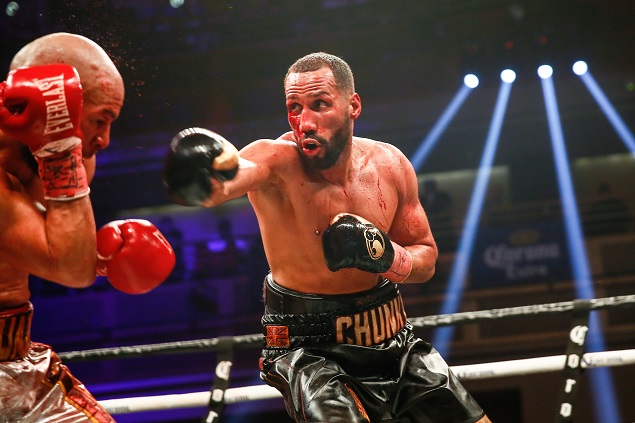
Two-time IBF junior middleweight titlist James DeGale (right) vs. Caleb Truax. Photo credit: Stephanie Trapp/Trapp Photos/Showtime
DeGale’s surge in the final six minutes enabled him to close Truax’s lead to 103-99 in overall connects and extend his advantage in landed jabs to 31-16. Truax, as expected, given his style, prevailed 87-68 in power connects. DeGale also was more precise in every category (30.3%-21.9% overall, 22%-9.8% jabs, 36.6%-28.2% power) but the round-by-round breakdowns had Truax up 7-4-1 overall and 9-2-1 power (thanks mostly to DeGale’s post-cut deceleration), while DeGale led 8-2-2 in landed jabs. So based on these numbers, Truax might have been unlucky to lose his belt. Judges Robert Hoyle and Don Trella submitted identical 114-113 totals but John McKaie saw a far different fight, in that he had DeGale a convincing 117-110 victor.
Although his reign was brief, Truax handled the loss like a champion.
“I thought I did enough to win the fight but I also thought I was pretty flat and didn’t get my shots off like I wanted,” he said.
Compared to the first fight, Truax indeed was flat. In fight one, an inspired Truax averaged 61.1 punches per round, attacked the body with abandon (96 power connects, 97 total connects) and out-landed DeGale 225-113 overall, 41-12 jabs and 184-101 power, while also being the more accurate man overall (30.7%-24.9%). Truax out-landed DeGale in every round but the 12th, and he fired 60 or more punches in a given round seven times, while DeGale’s highest output was 60 in round one. In the rematch, Truax’s highest output was 51 in round two, and, after being cut, he was mired in the 20s, 30s and 40s.
One would have thought the highly motivated DeGale would have been able to lift his game to a higher degree because he said he would retire if he lost to Truax a second time. But, at least statistically, DeGale didn’t perform much better in fight two than he did in fight one. He landed 14 fewer punches than in fight one (99 vs. 113) and averaged more than 10 fewer punches per round (27.3 vs. 37.8). He was more accurate overall but not by much (30.3% vs. 24.9%) and while his jabbing was more precise (22% vs. 5.5%), his power punching accuracy was down (36.6% vs. 43.3%) and he connected with far fewer power shots (68 vs. 101). Given this information, it could be said that DeGale’s victory was more a result of Truax’s erosion in the rematch than any improvements DeGale had made.
It remains to be seen whether this is the result of DeGale’s severe eye cut, Truax’s style, the Briton’s inactivity (two fights in 15 months) or if, at age 32, “Chunky” might be on the other side of his personal zenith. Now that he has his title back, we will get the chance to identify the answer.
*
Julian Williams’ majority decision victory over upset specialist Nathaniel Gallimore was a triumph of fundamentals. From the start, Williams’ command of the basics superseded Gallimore’s deadly left hooks, defiant competitiveness and glowing ring garb, all of which were displayed during this IBF junior middleweight title eliminator. Williams opened the fight behind a fast yet thumping jab that helped him establish his superiority at long range against the taller Gallimore. In the first five rounds, Williams led 31-14 in landed jabs, which led to leads of 77-45 overall and 46-31 power.
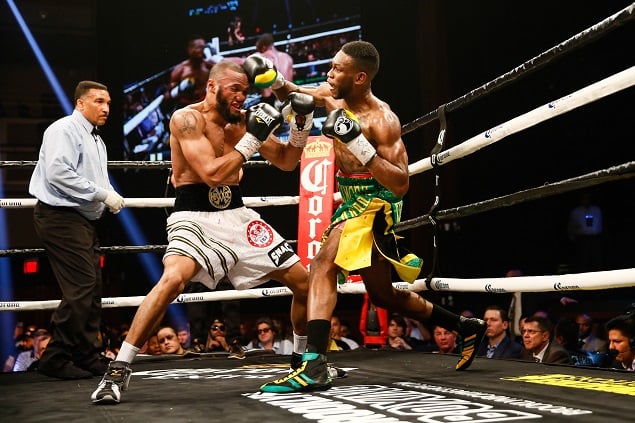
Junior middleweight contender Julian Williams (left) vs. Nathaniel Gallimore. Photo credit: Stephanie Trapp/Trapp Photos
Williams then closed the gap and proceeded to dominate the trenches with well-executed, razor-sharp blows. In rounds 7 through 11, Williams led 101-49 overall and 93-42 power, while largely abandoning the jab (8 of 46 in that five-round span, as opposed to 31 of 138 in the first five). The centerpiece of this phase of the bout was Williams’ body attack, which accounted for 33 of his landed punches in rounds 7 through 11 and 75 for the bout. After producing his best round in the 11th (33 of 64, 51.6% overall, 32 of 57, 56.1% power), the weary Williams largely shut down in the 12th, as he went 6 of 25 overall and 6 of 12 power. Gallimore, who produced a few energetic bursts but couldn’t sustain them, slowed from 10 of 44 in the 11th (9 of 37 power) to a mere 4 of 19 overall and 3 of 12 power in the final round.
The final numbers suggested a wide Williams victory, as he prevailed 191-107 overall, 39-25 jabs and 152-82 power as well as 36.9%-22.8% overall, 18%-13.7% jabs and especially 50.5%-28.6% power. The round-by-round breakdowns revealed that Williams led 10-2 overall, 7-3-2 jabs and 10-1-1 power. Two judges agreed (117-110 by Max DeLuca, 116-112 by Eric Cheek) but the third, submitted by veteran judge Patricia Morse-Jarman, read 114-114. Although I didn’t judge the fight round-by-round, I felt my total would have been in line with Cheek’s.
*
After Dennis and I packed our equipment – a formidable task requiring outside assistance because of the extremely tight quarters at ringside (we were pinned between a table and the front of The Joint’s stage) – we shook hands, left ringside and headed toward our respective abodes. On my way back to the room, I spoke with a member of Hurd’s team (who appreciated the recitation of Hurd’s statistical accomplishments, which included his landing the most total punches and the most power shots ever recorded by a Lara opponent tracked by CompuBox), as well as Julian Williams’ trainer Stephen “Breadman” Edwards, who, upon seeing me, impressively recalled the date and place of our first meeting (May 25, 2014 at the Montreal airport, following Williams’ eighth round TKO victory over Michael Medina, “J Rock’s” only fight outside the United States to date).
Even after returning to my room, my work day wasn’t yet finished because I still needed to enter the data from the four fights we counted into the master database, a process that took nearly 90 minutes to complete because each went the scheduled distance. There were other interruptions: As I entered numbers for the second fight, I suddenly heard a loud electronic whooping sound inside the room. Someone had apparently pulled the fire alarm and, after the second time the alarm sounded, a mechanical voice stated that I should be prepared to hear further instructions. I prepared for a potential evacuation but nothing came of it and I was then able to complete the data entry process. I turned out the lights at 1:15 a.m. – or 4:15 a.m. body clock time.
Sunday, April 8: Because of the extremely short turnaround, the three-and-a-half hours of slumber was more rest than sleep but the morning routines helped me regain sufficient energy to go about the going-home preparations. I checked out of the room at 5:45 a.m., secured a taxi a couple of minutes later and arrived at the airport well before my scheduled 7:40 a.m. boarding time.
I spent most of the next 90 minutes chatting with strangers – a favorite activity of mine. The first was a Southwest gate agent who, after I paid the $50 fee, upgraded my place in line from B-58 (118th position) to A-6 (sixth). His passion is basketball and, after just a few minutes of conversation, it was evident his knowledge was deep and detailed. He had taken steps toward fulfilling his dream of a basketball-centered profession but he needed a bit of inspiration to move forward. I believe hearing my story was just what he needed to hear and he said as much by the time we parted ways. We exchanged contact information and, hopefully, I’ll soon hear about how he changed his professional life and how much happier he is as a result. That certainly has been the case with me.
The other “stranger” with whom I extensively conversed was Anthony, my seatmate in row six (I had the window seat; he was on the aisle. Luckily we had no middle-seat counterpart). The ice-breaker occurred when he mentioned his hometown of Latrobe, Pennsylvania. and that he had spoken with fellow native Arnold Palmer many times. The fact that I was reading a book about golf (John Feinstein’s “The First Major: The Inside Story of the 2016 Ryder Cup”) provided a nice jumping-off point for the conversation to follow, which lasted for the entire three-hour flight. By the time we deplaned, we had established a bond which I hope will continue.
I spent the entire two-and-a-half hour drive listening to “Busted Open” radio (a pro wrestling-themed show) on Sirius XM 93. Unlike most weekend shows, this edition was live because WrestleMania 34 was to begin in just a couple hours’ time. I pulled into the driveway shortly after 7:30 p.m. and spent the rest of the evening watching the event on the WWE Network.
As of this writing, I do not know when or where my next trip will be. The extended home time will be good for me because I will have sufficient time to address the multitude of responsibilities that are before me – including an expanded presence inside THE RING magazine. Editor-in-chief Doug Fischer is making good on his promise to steer more stories my way and, while it will present a time-management challenge, it’s a challenge I gladly accept.
Until next time, happy trails!
*
Lee Groves is a boxing writer and historian based in Friendly, West Virginia. He is a full member of the BWAA, from which he has won 16 writing awards, including two first-place awards since 2011. He has been an elector for the International Boxing Hall of Fame since 2001 and is also a writer, researcher and punch-counter for CompuBox, Inc. He is the author of Tales from the Vault: A Celebration of 100 Boxing Closet Classics (available on Amazon) and the co-author of the upcoming book Muhammad Ali: By the Numbers. To contact Groves, use the e-mail [email protected].
Struggling to locate a copy of THE RING Magazine? Try here or
Subscribe
You can order the current issue, which is on newsstands, or back issues from our subscribe page.



